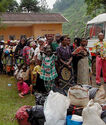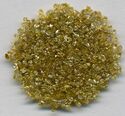
The flag of the Peoples' Republic of the Congo (Brazzaville).

The flag of Republic of the Congo (Brazzaville).
Overview[]

A 2006 satellite image of the DRC.
Hear is a list of nations that occurred in the Congo River's basin and the related Congo region in Africa.
The Congo[]
The French colony of Middle Congo (Moyen Congo) chose the name "Republic of Congo" upon achieving its independence on 1960 and was showing some signs of political instability.
President Marien Ngouabi, assumed the presidency of the Congo on December 31, 1968, after the coup earlier that month. A year later proclaimed Congo Africa's first "people's republic" and thus the overtly communist People's Republic of the Congo was born. Joachim Yhombi-Opango came to office in 1977 and was forced from office by Denis Sassou Nguesso in 1979. He ruled mostly via fear and terror, plus the odd bit of patronage and nepotism.
President Denis Sassou Nguesso aligned the country with the Eastern Bloc and signed a twenty-year friendship pact with the Soviet Union.
Pascal Lissouba, who became Congo's first elected president 1992–1997, but a civil war broke out in Congo in mid-1997. It devastated most of Brazzaville and killed thousands of Congolese.
In early October, the Angolan socialist régime began an invasion of the Congo and re-installed Sassou back in power by mid-October.
In the controversial elections in 2002, Denis Sassou Nguesso won with almost 90% of the vote cast. The opposition were mostly banned from running and the only one who was not banned boycotted the vote. Sassou passed a new constitution that restored a lot of what he was able to do in the communist era. A rebellion occurred in the Pool Region during 2003, but Pastor Ntumi soon singed a peace treaty and gave up the fight.
Sassou also won the following presidential election in July 2009, but it was also seen as very dodgy by most Western states. The results were, according to the Congolese Observatory of Human Rights, a non-governmental organization, the election was marked by "very low" turnout and "fraud and irregularities". About all that changed was that Sassou now ruled through more by fraud than thuggery and he was noticeably less left wing.
The Congo has both natural gas and diamonds, which are now recent major Congolese exports. It also has large untapped base metal, gold, iron and phosphate deposits.
The DRC/Zaire[]
History[]

The flag of Zaïre.

The flag of the DRC.

Tunnan jet 29670 "Gul Rudolf" in flight over Malmen. The Swedish UN forces used 5 of them from 1961 to 1965.

How Mobutu Screwed Up The Congo - Casual Historian
How President Mobutu ruined his realm.
Belgian had screwed up big time in the Congo Basin. The locals had been systematic repressed, economical exploited and racial abused by the Belgians from the 1870's to the beginning of World War 2. There was no attempt at a federal system and no desire to brake up the colony which sprawled over part or all of 7 major native nation as well as much sparsely populated tribal lands. African nationalism grew in the region during the 1950s and Belgian planned to give it independence in 1960.
The Belgian Congo achieved independence on 30 June 1960 under the name "République du Congo" (English:"Republic of Congo" or "Republic of the Congo"). Soon the provinces of Katanga and South Kasai launched secessionist separatist rebellions. Most of the 100,000 Europeans who had remained behind after independence quickly fled the country as anarchy prevailed. Africans then began to fill the rulings positions the Europeans had previously held.
The Congo Crisis and Simba_Rebellion saw the forces of the Democratic Republic of the Congo Stanleyville government, Republic of the Congo, Katanga, South Kasai, Simba rebels, Kwilu rebels fight it out through out the early and mid 1960s. The United Nations ONUC force, which had many nations like Sweden, Ethiopia and India amongst its ranks, tried to keep the peace. The Soviet Union, Belgium, United States, China, Cuba and Tanganyika all took sides and sent in troops. Belgium was apparently only interested in ruining the country so as to sure the native would fail to enjoy independence, whilst the USSR, China and the USA were out to install their puppets as the nation's new leadership. ~ 100,000 died in the war.
The pro-Western chief of staff of the new Congo army of the Armée Nationale Congolaise (ANC), Joseph-Désiré Mobutu Sese Seko stage a successfully coup against president the pro-Eastern Joseph Kasa-Vubu in 1961. A constitutional referendum in 1965 changed the nation's name to the "Democratic Republic of the Congo" and a residential decree during 1971 changed it again to the "Republic of Zaïre".
Post Cold war civil war and invasions[]
The civil war, invasions by neighbuoring states and subsequent regional wars that occurred after Mobutu's fall from power in 1996 have ruined the country. It has resulted in the deaths of 5,400,000 people since 1998 with more than 90% of those deaths the result of malaria, diarrhea, pneumonia and malnutrition, which were also aggravated by the mass displacement of people in to unsanitary and over-crowded living conditions.
DRC's largest export is raw minerals, with rubber constituting much less than in 1960, with China accepting over 50% of DRC's exports in 2012.
The nations' national names[]
For a while in the 1960s the French colony of Middle Congo (French: Moyen Congo) and the Belgian Congo both chose the name "Republic of Congo" upon achieving independence, so the two countries were more commonly known as "Congo-Léopoldville" and "Congo-Brazzaville", after their capital cities.
The list[]
- Democratic Republic of the Congo (From 1997)
- Republic of Zaire (1971-1997)
- The People's Republic of the Congo (1964-1965 and 1969-1992)
- Democratic Republic of the Congo (1964-1971 and from 1997)
- People's Republic of the Congo: Stanleyville Government (1964-1965)
- Republic of the Congo: Stanleyville Government (1960-1961)
- Autonomous State of South Kasai (1960-1961)
- State of Katanga (1960-1963)
- Republic of the Congo (1960-1964)
- Belgium: Belgian Congo (1908-1960)
- Independent State of the Congo (1885-1908)
- International Association of the Congo (1879-1885)
- International African Association
- Republic of the Congo (From 1960-1964)
- Republic of Congo (1958-69 and from 1992)
- Province of Cabinda
- Congo (Brazzaville) (1960)
- Congo (Kinshasa)
- Middle Congo (Moyen Congo) (in French Equatorial Africa)
- Belgian Congo (1908-1960)
- French Congo (in French Equatorial Africa)
- Republic of the Congo (Léopoldville)
- Republic of the Congo (Stanleyville)
- The Republic of the Congo operating from Stanleyville (1960-1961)
- Democratic Republic of the Congo (Léopoldville)
- The International Association of the Congo (1879-1885)
- The Independent State of the Congo (1885-1908)
- Portuguese-congo
- Cabinda Province in Angola
- Kôngo Kingdom (1390–1857) was the pre-Colonial native costal state around the mouth of the River Congo and northern Angola inhabited by the BaKongo tribe, and origin of the name modern "Congo". The rest of region was covered by many others like Luba and Lunda.
Also see[]
- Cold War
- All the Communist countries during the Cold War
- The anti-communist "Revolutions of 1989"
- List of sovereign states in 1990
- Life under communism
- All those Congos and DRCs
- Congo Crisis
- Simba Rebellion
- Cabinet of The Republic of the Congo
- The Congo and The DRC/Zaire
- Southern Africa
- West Africa
- Central Africa
- Horn of Africa
- Egypt
- Angola
- Ethiopia
- South-West Africa
- Libyan Arab Jamahiriya
- South Africa
- Minerals and fuel in central Africa
- All the Communist countries during the Cold War
- Cabinet of The Republic of the Congo
Links[]
- http://en.wikipedia.org/wiki/Republic_of_the_Congo
- https://www.cia.gov/library/publications/the-world-factbook/geos/cf.html
- http://en.wikipedia.org/wiki/Democratic_Republic_of_the_Congo
- http://en.wikipedia.org/wiki/Congo_Crisis
- http://www.mbendi.com/indy/ming/af/co/p0005.htm
- http://en.wikipedia.org/wiki/Congo_Crisis
- http://en.wikipedia.org/wiki/Simba_Rebellion
- https://en.wikipedia.org/wiki/Kingdom_of_Kongo
- https://en.wikipedia.org/wiki/Cabinda_Province#:~:text=Cabinda%20%28formerly%20called%20Portuguese%20Congo%2C%20Kongo%3A%20Kabinda%29%20is,Cabinda%2C%20known%20locally%20as%20Tchiowa%2C%20Tsiowa%20or%20Kiowa.
- https://www.yourdictionary.com/portuguese-congo



